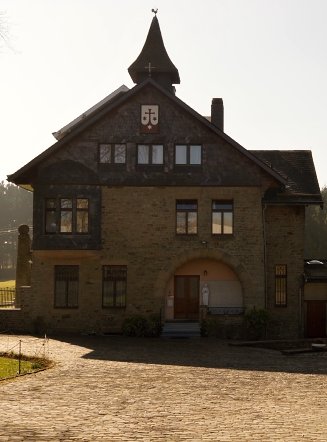1ST INFANTRY DIVISION
FOR THE PERIOD 1 DECEMBER - 31 DECEMBER 1944


HEADQUARTERS 26TH INFANTRY
APO .NO. 1, U.S. ARMY
1 January 1945
1 December 1944
Two attempts were made by "G" Company patrols to penetrate the enemy lines and ascertain what had happened to Companies "E" and "F" in the town of Merode. Though both patrols pushed aggressively, - finally the intense enemy artillery, mortar fire, and small-arms fire forced them back. "B" Company patrols swept the company front and found empty foxholes with abandoned equipment in them. By afternoon, the two companies plus the two supporting heavy weapons platoons from Company "H" were definitely given up as lost. The remainder of the 2nd Battalion, consisting of "G" Company, Headquarters Company and two platoons of "H" Company held its sector of the woods. To arm the 2nd Battalion forces, Major Hafermalz, the Regimental S-4, drew six (6) 60mm mortars, four (4) machine-guns, and gained permission to use the light machine-guns that had been issued the 2nd Battalion for the woods fighting.
Starting at 1115 hours, the 3rd Battalion moved through the woods southeast of Jungersdorf and swept the area of the enemy. The 1st Battalion at the same time swept the area just south of Merode. "B" Company in a sharp battle with a German force estimated at about a company drove the enemy out of the area and into the town, which was then taken under heavy artillery shelling.
By late afternoon, all three battalions had tied in for the night. The next day's plan called for the 1st Battalion to push to the edge of the woods south of Merode, and free the 3rd Battalion which was to sweep the area further southeast of Jüngersdorf.
2 December 1944
1st Battalion pushed at 0845 hours, and in about an hour "B" Company reported resistance encountered in the sweep of the area. A machine-gun nest with about a dozen German riflemen in support tried to stem the "B" Company sweep, but the weapon was knocked out in the clash, and the enemy survivors surrendered.
Battalion patrols throughout the morning. and afternoon brought back information that indicated the enemy had committed an entire battalion in front of the 1st Battalion and what was left of the 2nd Battalion. Some enemy artillery and mortar fire fell in the 1st Battalion area.
3 December 1944
Early morning, heavy enemy mortar fire fell on the 2nd Battalion positions. The 2nd Battalion forward observer called for artillery concentration on the enemy area 1200 - 1400 yards east of the 2nd Battalion positions along the Merode road, and the enemy mortar fire stopped after a few moments. Our mortar fire was laid down in turn on the northwest square of Merode, where enemy activity had been reported.
In the early afternoon, probing by enemy patrols in the 1st Battalion area was discouraged by our artillery fire. The 3rd Battalion reconnoitered the area down to "G" Company positions and found no sign of enemy resistance. The 1st Battalion moved forward slightly and then tied in with the other two battalions for the night.
4 December 1944
"G" Company located some houses in which the enemy had established a strongpoint, and 81mm and 4.2mm mortar fire placed upon the houses. "C" Company moved forward, with "A" and "B" Companies tying in with it.
News came of the impending relief of the unit on the following day. 2nd Battalion was to move at 0900 hours; the 3rd Battalion at 1500 hours and the 1st Battalion at 1000 hours 6 December 1944. A unit of the Ninth Infantry Division was relieving us.
5-16 December 1944
As planned the battalions moved out of the Gressenicher Forest, and moved to the vicinity of Aubel, Belgium. The entire unit was reported in the new area by evening of 6 December 1944. A shower point near the town gave the battalions facilities in cleaning up and in drawing clean clothing. USO shows and movie schedules provided entertainment for the men, with afternoon and evening shows giving all the men in the regiment opportunities for seeing the shows. Services were held, and special services arranged in all battalion areas. Troops were also given passes to the rest camp in Herve, and three-day passes to Verviers. Passes to Paris were given to about 1% of the command. In the period that the unit was in the Aubel area two groups had opportunities to go there.
16 December 1944
At 1145 hours the combat team (less tanks and tank destroyers) was placed on a six hour alert. All leaves, furloughs and passes were cancelled, but those already on leave were not to be recalled. At 2115 hours the unit was placed under a one hour alert. An enemy attack between the 5th and 8th Corps had developed into a twelve division drive. Five minutes later the Regimental S-6 and S~3 were ordered to report to V Corps Headquarters.
17 December 1944
Shortly after midnight, billeting parties reported to the CP. The 3rd Battalion was alerted to move at 0230 hours, with the 2nd following, and the 1st Battalion closing out of the Aubel area last.
The 3rd Battalion moved out on the exact moment, and about 0400 hours the battalion column was halted temporarily when word came through that paratroopers were dropping behind our lines. Reports had come through that the 12th SS Division taken Büllingen early that morning. From then on, the convoy travelled without lights and arrived at Camp Elsenborn at about 0700 hours. About 1400 hours the battalion moved to the town of Bütgenbach and then secured positions northwest of Büllingen. The 2nd Battalion meanwhile had reached the Bütgenbach area and had also jumped off north of the town. "E" Company secured the town, "G" Company took high ground overlooking the town, with "F" Company on "G" Company's right. By 1850 hours both 2nd and 3rd Battalions were reported in on their objectives.

Men belonging to the 26th Inf Regt / 1st Inf Div move up
to meet the German thrusts threatening Büllingen, December 17, 1944.
18 December 1944
The 26th Infantry was at this time under 99th Infantry Division control, and the mission given the unit at 0030 hours was to hold the town and occupy the hill mass west and southwest of the town astride the east-west road. The 3rd Battalion moved several hundred yards north of Büllingen and secured positions without resistance. About 1240 hours a scout car was observed on the road leading into the 2nd Battalion positions, and this was destroyed by anti-tank fire. The survivor in the German reconnaissance car proved from the Adolph Hitler Division, and it was from questioning this prisoner that the information was drawn that the enemy believed our sector lightly held. Towards evening, "K" Company reported armored vehicles about 1500 yards to their right front, near Büllingen. The 33rd Field Artillery laid in artillery on the town and fires were reported started in the town.
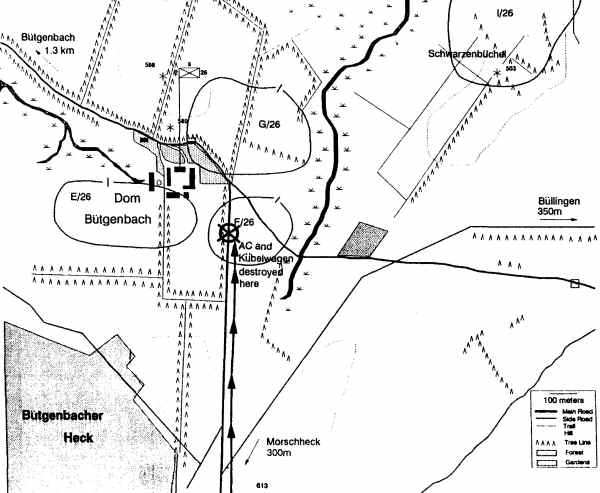
19 December 1944
Sharp probing attacks were made in the 2nd and 3rd Battalion sectors throughout the day. At 0225 hours, twenty truckloads of German infantry and some tanks detrucked at 943016, in front of the Company "E" positions. The 2nd Battalion called in the coordinates to Delta, and both the 33rd Field Artillery and Dandy fired at the enemy attacking force. The intense artillery fire knocked out three tanks and scattered the German infantry. By 0325 hours, the attack was dispersed. In the early morning, Company "A" moved to high ground 1000 yards south of Bütgenbach, to tie in with Company "B" which was next to the main road leading to the 2nd Battalion.
At 1010 hours two tasks and one company of enemy infantry were spotted south of the 2nd Battalion positions. One tank was halted by A-T gun-fire and the A-T gun in turn was taken under enemy rocket-gun fire which destroyed the gun. From noon on, the three battalion positions were under heavy artillery and mortar fire.

26TH INFANTRY AREA NEAR BÜTGENBACH: troops positioning antitank gun.
Towards the evening, 3rd Battalion laid in some mortar fire upon enemy patrols that tried to probe "K" Company positions, and scattered these before any small-arms fire developed.

20 December 1944
Machine-gun and tank fire to "E" Company's front about 0130 hours alerted the 2nd Battalion. The 33rd Field Artillery turned loose a barrage in front of the company positions and by 0145 hours all was quiet. It was to prove the lull before the main attempt.
At 0330 hours about twenty tanks and a battalion of infantry hit the 2nd Battalion positions, placing greatest pressure on Company "E" and Company "F". Maximum artillery fire was called for by Lt. Colonel Daniel and the 33rd Field Artillery tied in the efforts of all of its batteries as well as the batteries of the 955th Field Artillery and the 15th Field Artillery Battalions. The enemy artillery and mortar barrage upon the 2nd Battalion position proved intense as the enemy tank and infantry drove into the 2nd Battalion. Tanks succeeded in overrunning the lines between Companies "E" and "F" but the infantry remained in their places, trusting to the tank destroyers and anti-tank guns behind them to dispose of this threat to their rear. The enemy infantry seeking to follow through was unable to penetrate the lines that held under the most intense pressure ever experienced by the companies. The mist and smoke of the early morning made the fighting a matter of close range firing. Anti-Tank guns waited until the tanks were within point blank range before letting go their rounds, and the enemy rocket-gun teams following the tanks were able to subject the anti-tank crews to rocket-gun fire. The reserve force of the 2nd Battalion, a platoon of "G" Company, was quickly committed, and a company of the 1st Battalion requested. "C" Company was pulled out of the 1st Battalion line and swung over into the 2nd Battalion sector. Two platoons were committed to back up "F" Company and two platoons were placed in battalion reserve.
Five enemy tanks had pulled up to 100 yards of the Battalion CP, and were placing the CP under heavy, direct fire. Lt. Colonel Daniel stood firm, and still issued his order: Hold fast.
Anti-tank guns were shifted about and fired upon the enemy tanks. Two were knocked out, and the other three withdrew some distance. A lull occurred about 0530 hours, and radio communication was established between the battalion and regiment. Mines and tank destroyers were requested by the 2nd Battalion commander, three (3) more A-T guns were sent up at 1000 hours. An engineer platoon was also requested to help lay about 1000 anti-tank mines in front of the battalion positions, but these did not arrive until late in the afternoon. Heavy enemy fire still pounded the 2nd Battalion positions after the enemy tank and infantry withdrew. The withdrawals were only temporary, and throughout the morning and late afternoon the enemy launched three separate attacks, aimed at splitting "E" and "F" Companies. All of these efforts were frustrated, in large part due to the artillery's tremendously effective fire. Following a heavy attack launched by six (6) tanks and two companies of infantry which pressed close to the battalion CP once more before it was beaten off, the enemy stopped his attacks for the night.
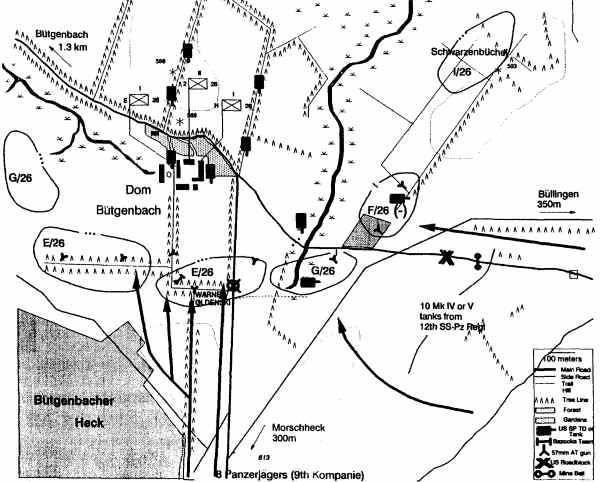
21 December 1944
At 0400 hours, following another heavy artillery barrage, the enemy tanks and infantry attacked the 2nd Battalion positions once more in an effort to force the main road running through Bütgenbach. Six (6) German tanks were destroyed by the artillery fire which fell close to the forward positions, and the flames of these lit the area of fighting. Enemy tanks succeeded in penetrating the lines this time through "G" Company's position. When anti-tank fire was placed upon these, the German tanks took refuge behind some buildings near the Battalion CP, and fired upon the battalion rocket-gun teams that tried to get within range. In an effort to drive the enemy tanks out, mortar fire was called down upon the battalion positions, when these tanks left the shelter of the buildings, the anti-tank crews fired upon them. It was slow work, for the tanks moved from building to building, and then systematically had to be mortared out. By 1600 hours, all enemy tanks, later discovered to be five in number, had been destroyed. Meanwhile, the infantry again held their positions and endured wave after wave of attacks by enemy infantry who persisted in moving through our terrific artillery barrage and came to close grips with our infantry. Our infantry fought the hostile tanks and infantry with hand-grenades, rocket-guns, BAR's and rifle grenades. Machine-guns were in almost constant operation, and the crews of tanks, tank destroyers and anti-tank guns remained at their posts until they had either destroyed the enemy or had been destroyed. By evening, the issue had been decided, and whatever enemy tank and infantry forces remained were forced to withdraw. Shortly afterwards the enemy again resumed his heavy artillery and mortar shelling of the Dom Bütgenbach ridge which the 2nd Battalion had held fast.
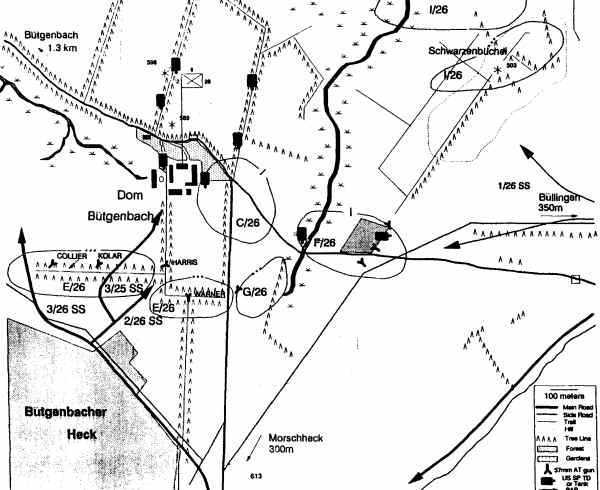
22 December 1944
The enemy hat not finished in his efforts to break through. This time, he chose to attack the 1st and 3rd Battalion sectors. "A" Company was attacked at 0630 hours, with six (6) enemy tanks and several hundred infantry hitting the left platoon of the company. Again the enemy tanks were able to penetrate the line, but the infantry was stopped by a courageous stand put up by the overrun infantry and the platoon on the right side of the company line. In a daring, move, Company "B" was swung out of the battalion line, and working south, from the town, it worked through the one platoon of Company "A" that had held its position and then swung east to drive the enemy back. By 1430 hours the situation had stabilized. The enemy tanks had been forced back and two of them destroyed by artillery as they tried to reach their own lines.
"K" Company also was placed under pressure by several tanks and one company of infantry, but the hostile thrust was turned back. An anti-tank gun knocked out a Mark V tank that tried to swing its machine-guns on the troops as soon as it broke through the line.
Towards evening, our artillery caught a long enemy column on the road to Schoppen and pounded it. Save for some enemy shelling, no further attacks were made.
The enemy attempts had been costly: from thirty (30) to thirty-five (35) German tanks had been destroyed, and some 1200 casualties inflicted upon the German infantry.
23 December 1944
Early morning the 2nd Battalion outposts spotted a large enemy column going east out of Büllingen, and Delta fired a mission on this enemy group which succeeded in scattering it. Outside of some desultory mortar fire landing in the 1st Battalion area, all was quiet during the day. Towards evening, two enemy tanks to the front of "I" Company were taken under our tank and mortar fire, and one of the enemy tanks was destroyed. The enemy crew abandoned the second tank, which was hit and set afire. 2nd Battalion patrols established that 30 tanks had been knocked out in their area alone.
Orders were issued by higher headquarters that all personnel in the forward areas were to wear gas masks at all times.
In a re-arranging of defenses, the 2nd Battalion remained in place, with the 1st and 3rd Battalions securing high ground closer to the 2nd Battalion positions.
On this day, the task of mining the areas in front of the regimental positions was begun. It was to continue throughout the remainder of the month.
24 December 1944
2nd Battalion patrols probing the enemy positions in the vicinity of Büllingen were turned back by heavy small-arms and machine-gun fire. 3rd Battalion patrols throughout the night intercepted and clashed with enemy patrols close to their lines and turned the hostile patrols away with losses.
"C" Company patrols reported that many machine-guns and machine-pistols had been left by the Germans as they had retreated after their attempts to force the 2nd Battalion positions.
The 99th U.S. Infantry had reported that enemy paratroopers had been dropped in their sector, but none were reported in the 26th Infantry sector, though the unit was alerted against this enemy activity.
Towards evening, Delta fired a mission at Büllingen, when enemy vehicular traffic was reported in town by 2nd Battalion outposts. The rest of the night proved without incident. Mines were laid by an engineer detail, with the general plan to work the minefield so that it joined with the one the 18th Infantry laid.
25 December 1944
About 0300 hours, "C" Company reported a tank moving to their front, and artillery was laid down in that area. The sound of the enemy motor ceased soon after the volleys registered in the area. About 0800 hours, two enemy trucks came within range of the 2nd Battalion positions. Both were knocked out with mortars. Another two enemy trucks going west out of Büllingen were blown up by our mines.
Engineer details working at the same task of laying mines discovered a 20 foot gap in the mine field in front of "C" Company area. It had evidently been lifted by enemy. The gap was closed, and a security guard established so that enemy patrols would be unable to approach the mine fields or attempt clearing them.
26 December 1944
"B" Company area shelled at 0100 hours, and gun flashes of the enemy batteries spotted and relayed to Delta. Later in the morning, several trucks carrying lumber for enemy troops were taken under 3rd Battalion mortar fire and destroyed.
Mines again laid in front of regimental positions, and battalion defenses strengthened.
27 December 1944
Two enemy tanks to the 2nd Battalion front were knocked out by artillery fire early in the morning. Enemy vehicular traffic being reported in town, the northeast and southeast road out of Büllingen was placed under friendly artillery fire.
Planes had been spotted in the regimental area, and several instances of bombing and strafing had been reported. At 1900 hours, from higher headquarters came the order not to fire at P-47s as no enemy pilots were believed operating this type of plane.
The work of laying mines neared completion.
28 December 1944
At first daylight, artillery fire was laid on enemy trucks and personnel spotted at 918013. 2nd Battalion patrols located enemy mortar positions at 934009, and a platoon of Germans at 943006. Mortar fire on both enemy targets was placed with good results.
The 2nd and 3rd Battalion positions were both subjected to enemy attacks. Starting at 1700 hours, the enemy first threw approximately 300 rounds of artillery and mortar, and then attacked. The alerted companies threw off the hostile forces, inflicting heavy losses. After "L" Company had been under some pressure, it pushed and reached a point south of the railroad. The Germans offered some resistance but fell back.
29 December 1944
After a night without incident, at 0600 hours "I" Company outposts reported enemy vehicles on the Büllingen road. Delta fired a mission on this enemy traffic. The rest of the day proved quiet. Mine laying details continued with the work of strengthening the regimental defenses.
30 December 1944
At 0800 hours a truckload of German infantry was spotted at 932007, and two volleys of artillery wiped out about 95% of them. Enemy mortars that had been firing at the 2nd Battalion positions were also placed under artillery fire that silenced these.
31 December 1944
The usual activities prevailed on this last day of the year. Enemy patrols reported no contact.
SUMMARY
The month had begun with the unit engaged in clearing the enemy out of the Gressenicher Forest west of Duren, accomplishing all assignments given it. The. period of rest and rehabilitation had been cut short by the German breakthrough into Belgium, and the regiment had responded brilliantly in throwing back the enemy in the Bütgenbach sector, with terrific losses to the German attacking forces.
The year closed on another glorious fighting chapter of the unit.
| GAINS AND LOSSES AND DAILY STRENGTH FOR THE MONTH OF DECEMBER 1944 | ||||||
| STRENGTH | GAINS | LOSSES | ||||
| DATE | OFF | EM | OFF | EM | OFF | EM |
| 1 | 120 | 2388 | 8 | 1 | 53 | |
| 2 | 115 | 2313 | 1 | 10 | 6 | 85 |
| 3 | 114 | 2338 | 64 | 1 | 39 | |
| 4 | 114 | 2313 | 2 | 19 | 2 | 44 |
| 5 | 114 | 2308 | 12 | 17 | ||
| 6 | 115 | 2314 | 1 | 20 | 14 | |
| 7 | 116 | 2308 | 1 | 15 | 21 | |
| 8 | 117 | 2287 | 1 | 17 | 38 | |
| 9 | 118 | 2274 | 1 | 12 | 25 | |
| 10 | 118 | 2284 | 32 | 22 | ||
| 11 | 133 | 2314 | 16 | 48 | 1 | 18 |
| 12 | 134 | 2320 | 29 | 1 | 23 | |
| 13 | 133 | 2329 | 22 | 1 | 13 | |
| 14 | 135 | 2545 | 2 | 224 | 8 | |
| 15 | 136 | 2579 | 1 | 42 | 8 | |
| 16 | 141 | 2582 | 7 | 18 | 2 | 15 |
| 17 | 142 | 2586 | 1 | 12 | 6 | |
| 18 | 142 | 2562 | 9 | 33 | ||
| 19 | 144 | 2544 | 2 | 9 | 27 | |
| 20 | 142 | 2477 | 2 | 8 | 69 | |
| 21 | 139 | 2386 | 7 | 3 | 98 | |
| 22 | 135 | 2673 | 376 | 4 | 89 | |
| 23 | 145 | 2730 | 11 | 113 | 1 | 56 |
| 24 | 159 | 2822 | 15 | 187 | 1 | 95 |
| 25 | 159 | 2795 | 6 | 33 | ||
| 26 | 156 | 2882 | 145 | 3 | 58 | |
| 27 | 157 | 2867 | 1 | 34 | 2 | 49 |
| 28 | 157 | 2816 | 1 | 9 | 1 | 60 |
| 29 | 157 | 2789 | 12 | 39 | ||
| 30 | 156 | 2788 | 28 | 1 | 29 | |
| 31 | 156 | 2888 | 128 | 28 | ||
JOHN E, REYNOLDS
1st Lieut., 26th Infantry
Personnel Adjutant.
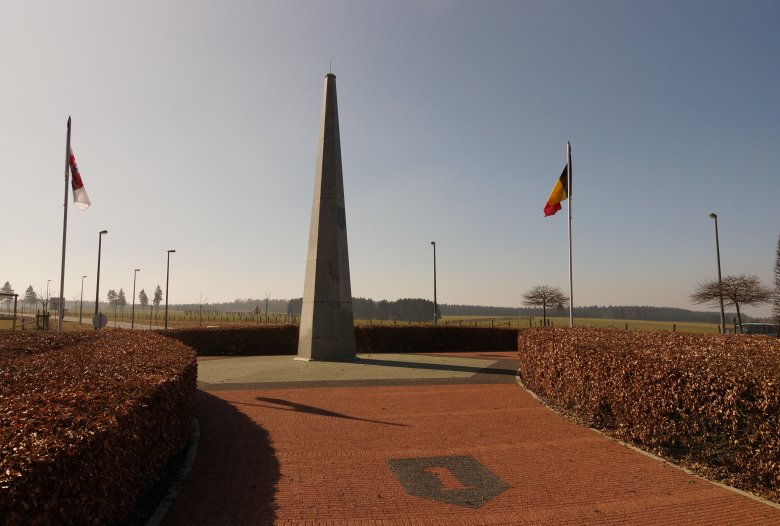
This large stone obelisk is dedicated to 458 fallen soldiers of the 1st Infantry Division.
It 's erected at the spot where they held off the attacks from the German 12th SS Panzer division and prevented the German 6th SS Panzer division from completing their attempted drive from Büllingen to Liège.


